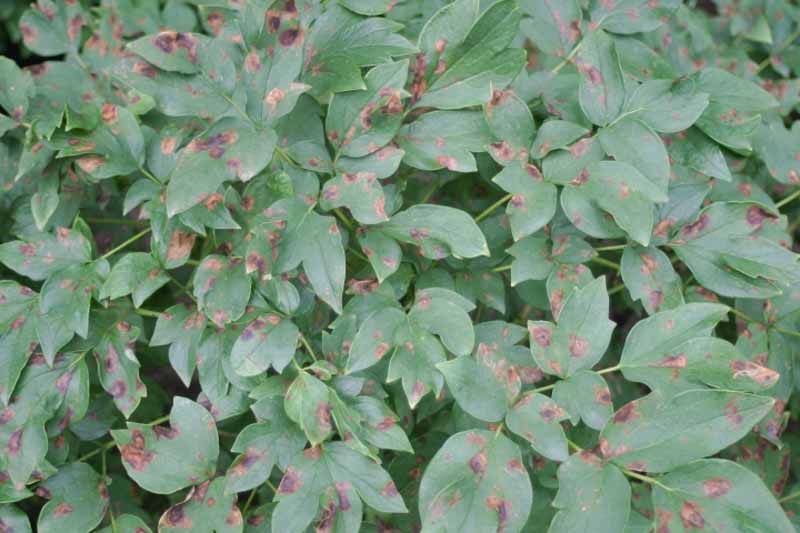How to Identify, Prevent, and Treat Peony Blotch, Red Spot, or Measles
Peony Blotch, also called red spot or measles, is caused by the fungal pathogen Cladosporium paeoniae, a disease primarily affecting peonies. This disease can impact the aesthetic value of these popular garden plants.
This fungal disease is found in regions where peonies are commonly cultivated, particularly in temperate climates. It can occur in any area where peonies are grown but is more prevalent in regions with humid and wet spring and summer weather.
Identifying Peony Blotch involves observing specific symptoms on the plant:
Reddish-Brown Spots: The initial sign of Peony Blotch is the appearance of small, reddish-brown spots on the leaves. These spots are typically round and can appear on the upper surface of the foliage.
Raised Spots: As the disease progresses, these spots may become raised and more noticeable, resembling measles on the leaves, hence the name.
Blotches and Purplish Coloring: Over time, the spots can enlarge and merge to form blotches. The affected areas may turn a darker, purplish-black color.
Stem and Flower Symptoms: In addition to leaf symptoms, you may also notice similar reddish-brown to black spots on the stems and flower parts.
Leaf Deterioration: Severely affected leaves can become discolored and distorted. In extreme cases, the leaves may wither and die prematurely.
Weather Correlation: The disease is more prevalent during wet, humid spring weather, and symptoms are often more severe in such conditions.
No Major Plant Damage: While the disease impacts the aesthetic value of the peonies, it typically does not cause significant harm to the overall health of the plant.
Recognizing these symptoms early is crucial for managing Peony Blotch. If you suspect your peony plants are affected, implementing proper cultural practices and possibly fungicidal treatments can help manage the disease and prevent its spread.

Certain conditions and factors favor the development and spread of this disease:
Moisture and Humidity: The fungus thrives in wet and humid conditions. Extended periods of rain, heavy dews, or high humidity provide the ideal environment for the fungus to grow and spread. Overhead watering that keeps leaves wet for long periods can also contribute to developing the disease.
Poor Air Circulation: Dense plantings where air movement is restricted can create a microclimate with higher humidity around the foliage, favoring fungal growth. Good air circulation is crucial in preventing many fungal diseases, including Peony Blotch.
Cool Temperatures: While the fungus can exist in a range of temperatures, it particularly thrives in cooler weather, which is often coupled with higher moisture levels in the spring and fall.
Overhead Watering: Watering methods that leave the foliage wet for extended periods, especially overhead sprinklers, can increase the risk of Peony Blotch.
Plant Debris: The fungus can overwinter in infected plant debris. Fallen leaves and stems left in the garden can harbor fungal spores, which can reinfect plants in the following growing season.
Lack of Sunlight: Areas shaded or receiving little sunlight can remain damp for longer, creating favorable conditions for the fungus.
Plant Stress: Plants that are stressed due to poor nutrition, improper planting, or other environmental factors may be more susceptible to infection.
Preventing and controlling Peony Blotch involves a combination of cultural practices and, if necessary, fungicidal treatments:
Improve Air Circulation: Space peony plants adequately to ensure good air movement around them. Prune surrounding vegetation if needed to reduce humidity and lower the risk of fungal diseases.
Water Appropriately: Water peonies at the base to avoid wetting the foliage. If overhead watering is necessary, do it early in the morning so the leaves have time to dry out during the day. Avoid overwatering to prevent overly moist soil conditions.
Sanitation: Regularly remove and destroy any affected plant parts during the growing season. In the fall, clean up and dispose of all peony foliage, especially if it showed signs of infection, to reduce the number of fungal spores that can overwinter.
Fungicide Applications: If Peony Blotch has been a recurring problem, consider applying a fungicide labeled for use against Cladosporium paeoniae. Start treatments in the spring when the new shoots are a few inches tall and follow the manufacturer’s instructions for application frequency and safety.
Avoid Overcrowding: Ensure peonies and other plants in your garden are not too crowded. This helps in reducing humidity levels around your plants, making conditions less favorable for the fungus.
Plant in Full Sun: Plant peonies in a location that receives full sun as it helps in faster drying of foliage and reduces the conditions favorable for fungal growth.
Healthy Plant Practices: Keep your peonies healthy with appropriate fertilization and care. A healthy plant is more resistant to diseases.
By combining these preventative and control strategies, you can effectively manage Peony Blotch and maintain the health and beauty of your peony plants. Regular monitoring and early intervention are key to preventing the spread and severity of the disease.
Create a membership account to save your garden designs and to view them on any device.
Becoming a contributing member of Gardenia is easy and can be done in just a few minutes. If you provide us with your name, email address and the payment of a modest $25 annual membership fee, you will become a full member, enabling you to design and save up to 25 of your garden design ideas.
Join now and start creating your dream garden!
Create a membership account to save your garden designs and to view them on any device.
Becoming a contributing member of Gardenia is easy and can be done in just a few minutes. If you provide us with your name, email address and the payment of a modest $25 annual membership fee, you will become a full member, enabling you to design and save up to 25 of your garden design ideas.
Join now and start creating your dream garden!